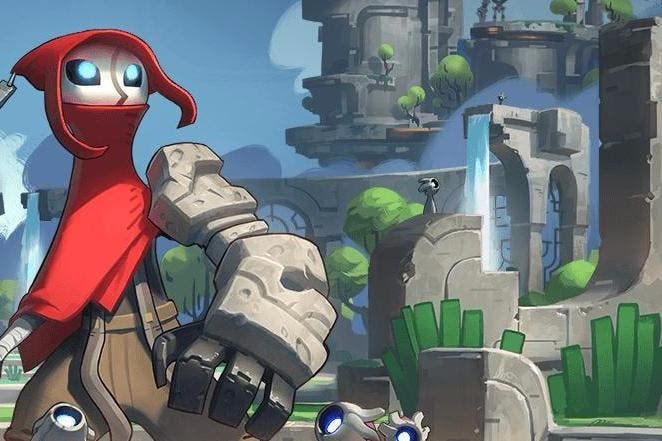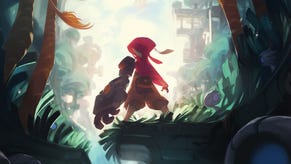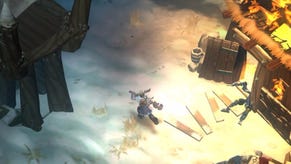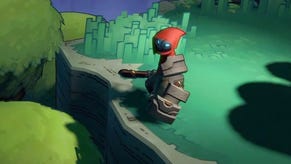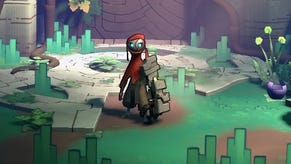Hob sees the makers of Torchlight trading Diablo for Zelda
Escapement to the country.
Metal in games is almost always the same kinds of metal: iron or steel, a flash of dented silver with a speckle of rust and a scattering of rivets. In Hob, however, the metal of choice is copper, and copper turns out to be transformative. Hob takes place in an ancient, long dormant machine world. A world in which nature - weird, prickly nature - has staged a comeback, in which grass has grown around vast diodes and escapements and plug sockets that litter the landscape. Copper pokes out of the ground everywhere, and gives a weird alien shape to the spine of each outcropping, each mini-mountain. Beautiful copper, somehow warm and somehow, well, ancient.
Hob is the latest from Runic Games, the developer behind Torchlight and Torchlight 2. Those were both beloved action RPGs, in the style of Diablo, and - due to Runic's founding members, who worked on those games at Blizzard - from the same lineage as Diablo too. Hob is a bit of a departure. It's still sort of a top-downish affair, even if the camera is tilted a bit to give a wider view of the landscape, but it takes its main cues from a different kind of action RPG tradition. Hob feels a lot like Zelda, from the brisk sword-swipe combat to the grass you can hack through to regain health orbs, and even the secondary meter that powers what amount to magic attacks and special abilities. Combat itself seems pleasantly sparse, however. Instead, beneath that thin coating of whacking things around is a distinctly Hyrulian emphasis on exploration of the old and numinous. And beneath that you hit the bedrock of an intricate world that doesn't so much house puzzles as feel like one giant puzzle in its own right.
I played through a short demo late last week, and I'm still thinking about it. We're a little way into the game, and exploring a stretch of grassland, stone and copper erupting out of the ground to form gently curving mountains and towers. The protagonist in this world is a lithe robo-person in a red cloak, and their job, it seems, is to bring ancient things back online. This means manipulating the environment in some extremely satisfying ways, moving the entire face of a cliff around so you can scale it, for example, removing the vast chains that hold a huge wall in place, or leaving the overworld behind entirely and descending deep into various subterranean dungeons in order to bring hidden lands back to the surface.
The puzzles are wonderfully tactile, hinging on things that can be grabbed and pulled around to great consequence. Switches are huge, and they move hulking stone bridges that move on neat rails. It's the kind of game where you solve a single puzzle by tackling separate elements, each one with its own twist. A lot of the time, you'll be powering up a vast bit of machinery one section at a time, the world around you changing drastically as a result of your actions.
Your combat abilities generally carry over to your caretaking duties: a roll that gets you out of trouble is good for navigating ledges at speed, while an electrified dash that stuns enemies can zip you across gaps between pieces of machinery. Best of all, there's a charged mega-punch that is perfect for booting up a section of architecture that you've primed with electricity. Who built stuff this big, this intricate, this planet-consuming? Hob doesn't have to explicitly pose these questions; they are implied in everything you see, everything you do.
Underground there are flashes of bold design that break up the traversal and the puzzling. At one point I drop into a copper pipe and have to navigate through it to a distant exit - but the camera doesn't come into the pipe with me, and the game doesn't pick me out in silhouette. It's a wonderful piece of theatre, and I feel terribly vulnerable poking around in the dark. It's presumably dark inside the pipe, and this is a great way of getting at that. It must have been hard for a designer to look beyond their instincts to provide basic information, in order to make such a lovely moment work as well as it does.
At another point, I am transformed into sheer energy as I zip between nodes to cross a vast underground cavern. It's a moment to sit back and enjoy the ride, and Hob plays up to it really beautifully, flinging me out on a prolonged journey that sees me pinning back and forth until I have no idea where I am when I finally come to a stop.
Hob is full of stuff like this, and while the puzzles themselves are all clever and leave me with a sense of busy satisfaction, it's these incidental touches of flair that really keep me playing. Towards the end of the demo, I work my way over to a ledge and the action pauses for a few seconds. There's no collectable - although this world is filled with secrets and collectables, most of which power you up in some way or another. Rather, it's a rest point - a vantage point, like a viewing car park at the edge of the Grand Canyon. Below me, poking out of the subterranean gloom, I see platforms covered with sections of a forgotten forest, the treetops gently rounded in a way that reminds me of A Link to the Past. Minutes later, I will be working out how to raise these platforms, and their forests, back to the surface. But for now, I can just take it all in.
